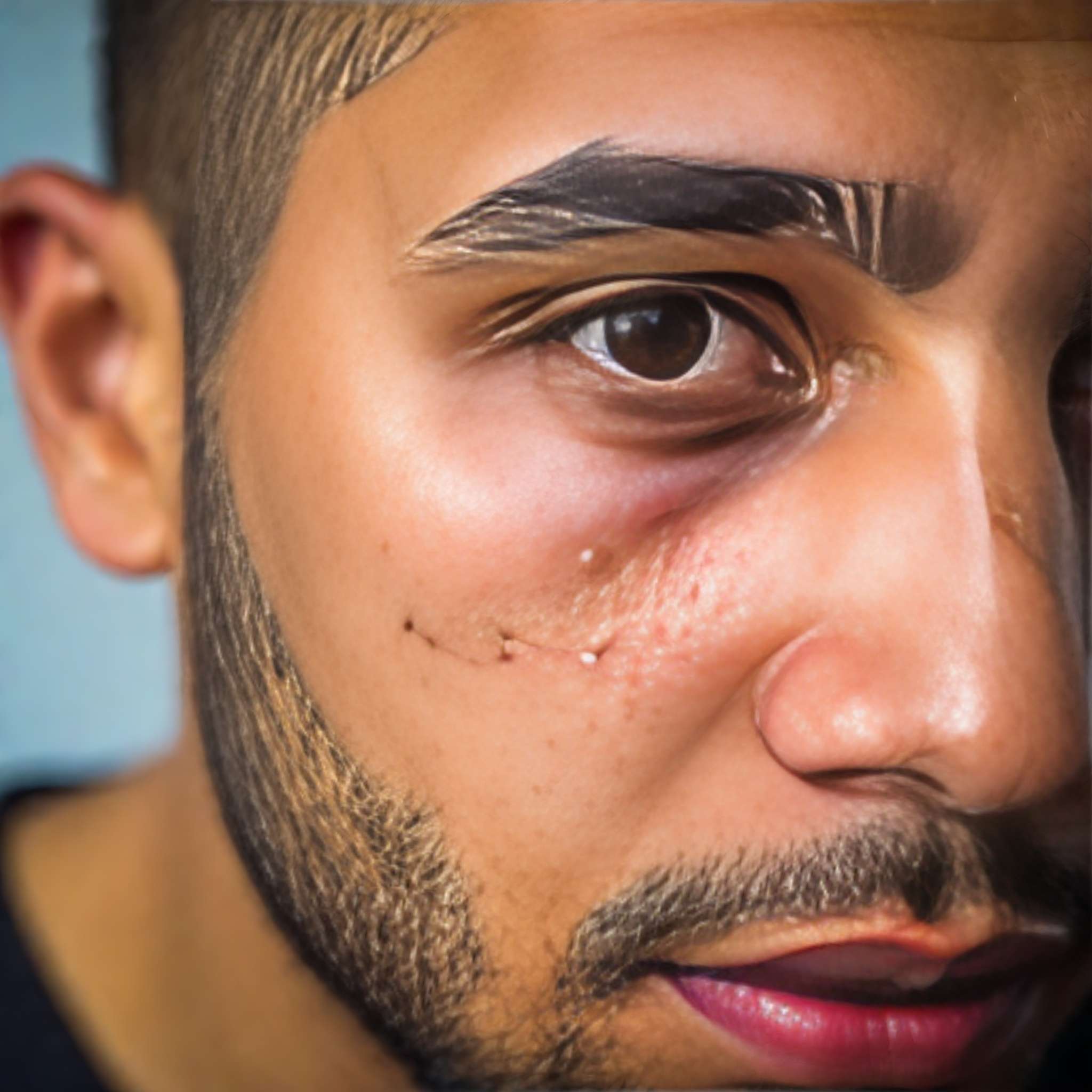Acne is a common skin disorder that affects a large number of people, yet not all cases are alike. Acne is basically of two types: fungal acne and hormonal acne, each with its own nature, look, and cure.
Understanding the differences is critical for effective treatment. In this post, we’ll look at what fungal acne and hormonal acne are, how to recognize them, and how to treat them.

Image 1: Fungal Acne
Download E-BookTable of Contents
What is fungal acne?
Fungal acne, also known as Malassezia folliculitis, differs from ordinary acne. The disorder is caused by an excessive multiplication of yeast, which is a fungal organism that naturally sits on the surface of your skin.
The over proliferation of this yeast leads to the infection of hair follicles, resulting in the development of small, bothersome, and uniformly scattered pimples. These clusters of pustules commonly appear on the chest, back, and sometimes on the face.

Image 2: Fungal Acne on Chest
Causes of Fungal Acne
Fungal acne can be caused by numerous factors, including:
Excessive Sweating
Yeast thrives in warm, wet settings, thus sweat is an ideal breeding site. Tight clothing can trap sweat against your skin, which promotes yeast growth.
Humidity
Living in a humid area increases the risk of fungal acne. Antibiotics can disturb the equilibrium of bacteria and yeast on your skin, resulting in an overgrowth of yeast.
Immunosuppression
A weaker immune system can impair the body’s ability to keep microbial populations in balance, allowing yeast, such as Malassezia, to grow unchecked on the skin. This overgrowth can disrupt the natural microbiome and lead to fungal acne, characterized by small, itchy, and uniform pimples.
Unlike bacterial acne, fungal acne is caused by an imbalance of yeast, highlighting the crucial role of a robust immune response in maintaining skin health and preventing infections
What is hormonal acne?
It is caused by fluctuations in your hormone levels. It typically develops on the lower half of the face, such as the chin and jawline, and is deeper and more inflammatory than other types of acne.
This type of acne is most common in teenagers throughout puberty, although it can also affect adults, particularly women during menstruation, pregnancy, or menopause.

Causes of Hormonal Acne
Hormonal acne is affected by:
Hormonal Fluctuations
Changes in hormones, particularly androgens, can cause increased oil production in the skin, resulting in clogged pores and acne.
Stress
It does alter hormones, which can aggravate acne. Stress hormones include cortisol and androgens. How they can damage your skin and worsen acne:
Cortisol, the stress hormone, increases skin sebum production. Sebum clogs pores, causing acne.
Stress can also boost androgens, masculine hormones found in both men and women. Androgens activate sebaceous glands, increasing oil production and acne risk.
Stress can aggravate inflammation. Increased inflammation can worsen acne, which is partly inflammatory.
Immune Response: Stress weakens the immune system, making it harder to fight acne-causing germs and cure lesions.
Diet
Dairy and high-glycemic foods may cause hormonal acne, as cited by the different research groups. Dairy products may increase insulin-like growth factor (IGF-1), which can worsen acne. High-glycemic diets, which induce fast blood sugar spikes, may boost insulin levels, causing skin irritation and oil production, which contribute to acne.
Genetics
Yes, having a family history of acne can indeed increase your risk of developing hormonal acne. Genetic factors play a significant role in the likelihood of experiencing acne, including hormonal acne.
If one or both of your parents had acne, you are more likely to develop it as well. This predisposition is due to inherited characteristics that can affect the skin’s sebaceous glands, hormone levels, and the overall tendency for inflammation and clogged pores.
How To Identify Fungal Acne
Identifying fungal acne might be difficult since it resembles bacterial acne. Here are several indicators that you may have fungal acne:
Fungal acne is most commonly found on the chest, back, and face. The pimples appear small, homogeneous, and irritating. They may appear in bunches.
Traditional acne treatments do not show any improvement: If standard acne treatments (such as benzoyl peroxide or salicylic acid) do not work, you may have fungal acne.
How to Identify Hormonal Acne?
Hormonal acne has particular characteristics that distinguish it from other types of acne.
Location: It usually appears on the lower face, including the chin and jawline.
Timing: It frequently corresponds with menstruation periods in women.
Types of pimples: Hormonal acne is deeper, bigger, and more painful than typical pimples.
Best Ways to Treat Fungal Acne
Treating fungal acne entails managing the yeast overgrowth. Here are the best approaches to handle it:
Antifungal treatments include lotions, shampoos, and oral drugs. Ketoconazole shampoo, for example, can serve as a body wash.
Shower After Sweating: A quick shower after sweating can help eliminate sweat, which stimulates yeast growth.
Wear Loose clothes: Loose clothes allows your skin to breathe and lowers the likelihood of sweat becoming trapped against your skin.
Avoid using heavy skincare products: Products that are overly thick or oily may feed the yeast. Choose lightweight, non-comedogenic goods.
Probiotics: Taking probiotics can help keep your skin’s bacteria and yeast levels in balance.
Best Ways to Deal with Hormonal Acne
Managing hormonal acne entails balancing hormones and implementing an acne-specific skincare regimen. Here are the best approaches to handle it:
Topical treatments include retinoids, benzoyl peroxide, and salicylic acid. These can help clear clogged pores and minimize inflammation.
Hormonal Therapies: Birth control pills and other hormonal treatments can help regulate hormones and minimize acne.
Dietary Changes: Reducing your diet of dairy and high-glycemic meals may assist. A well-balanced diet rich in fruits, vegetables, and whole grains can help you have healthier skin.
Stress Management: Activities such as yoga, meditation, and exercise can help reduce stress and control hormone changes.
Consult a dermatologist. A dermatologist can provide individualized treatment programs, including prescription drugs if needed.
Preventive Strategies for Both Types of Acne
Whether you suffer fungal or hormonal acne, these general preventive steps can help keep your skin clear:
Good Skincare Routine: Cleanse your skin twice a day with a gentle cleanser, moisturize, and apply sunscreen.
Avoid Picking Pimples: Picking causes scarring and additional infection.
A healthy lifestyle includes eating a balanced diet, staying hydrated, getting adequate sleep, and exercising regularly.
Washing your face too often might deplete your skin’s natural oils, causing it to generate more oil and potentially contributing to acne.
Conclusion
Dealing with acne can be frustrating, but knowing what sort of acne you have is the first step toward effective therapy. Fungal acne, caused by a yeast overgrowth, necessitates antifungal treatments and proper cleanliness. Hormonal acne, caused by hormonal fluctuations, can be treated with topical medications, hormonal therapy, and lifestyle modifications.
You can get clearer skin and better skin health by determining the type of acne and treating it appropriately. Remember that if over-the-counter medications do not work, it is always a good idea to see a dermatologist for expert advice and treatment.
Message from the content writers
Thank you for taking the time to read our article. We hope you found it insightful and enjoyable. Your feedback is valuable to us, so please don’t hesitate to share any suggestions or comments in the section below. We’re committed to continuously improving our writing skills to better serve you. Thanks again for your love and support.


Leave a Reply